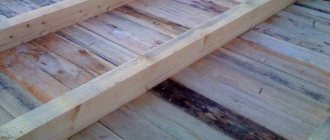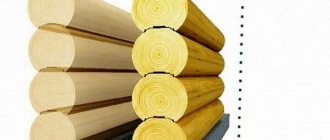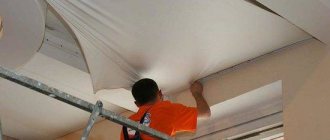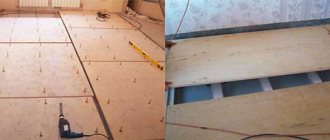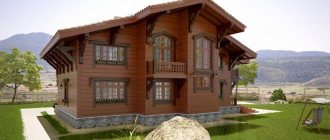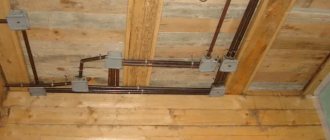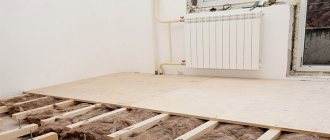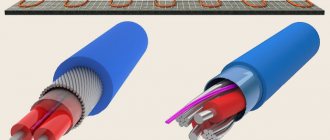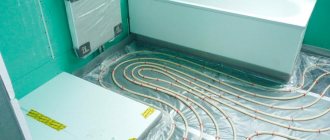- Infrared film heated floor
- Heating cable
- Heating mats
A building made of wood does not imply a thick monolithic cement floor screed into which a “traditional” water or cable (electric) heated floor is laid. As a rule, in this kind of house, the interfloor ceiling and foundation (most often logs) are wooden. In this case, the floor covering, for example, solid boards (tongue and groove), can be laid on the logs themselves or, in the case of laminate and parquet, on top of sheet materials such as plywood and OSB.
In this regard, many have difficulties in choosing and installing heated floors in a wooden house. Our article will help you figure this out.
underfloor heating systems . Let's look at each of them.
Infrared film heated floor
Thermal film is the simplest and most effective type of heated floor in a wooden house, designed specifically for heat-sensitive coatings (tongue and groove, linoleum, laminate, parquet and carpet) and its installation does not require screed or glue. The film is installed on any floor base: old covering, rough wooden floor and wood-containing sheet materials (plywood, chipboard, fiberboard, OSB).
Film heated floors are a source of additional heating, and with good thermal insulation and installation on 70-80% of the entire floor area, they are the main source of heat.
Warm floor for the main heating of a wooden house:
- CALEO Platinum 230 W/m2;
- CALEO Gold 230 W/m2;
- KEEPLY Optimal 200 W/m2;
- VIOLET FLOOR 210 W/m2.
As an additional source of heat and maintaining a comfortable indoor climate:
- CALEO Line;
- KEEPLY Basic 140 W/m2;
- CALEO Gold 170 W/m2;
- CALEO Platinum 230 W/m2;
- VIOLET FLOOR 130 W/m2.
Installation of such a warm floor is the same for all rooms. Detailed instructions are provided in the following article.
Variations on a theme
In our country, based on Finnish technology, which facilitates the design and allows one to abandon monolithic casting, its variations have appeared - the principle remains, but the materials have been increased:
Gypsum fiber sheets (GVL) - compared to plasterboard, they are denser, more resistant to bending and deformation, and contain cellulose fibers and other additives that increase their technical characteristics. For wet rooms, a moisture-resistant variety (GVLV) is used;
ТishinFORUMHOUSE user
In such a floor, instead of plasterboard, it is better to use gypsum fiber sheets (GVL). I myself am now considering a dry screed for implementation in my home, I will only replace the bottom layer with OSB. I will assemble the middle part from two layers of gypsum fiber board.
Chipboard, OSB, plywood - in terms of heat transfer, this design is worse, since wood and its derivatives act as an insulator. Ready-made sets of heated floors on a dry screed made of chipboard sheets, with grooves selected for hinges, are sold, but not everyone can handle their cost.
boatmasterFORUMHOUSE user
Logs, with a pitch of 60 cm, plus insulation - 35 cm, OSB base, then a 20 mm pipe, plus a 5 mm clip, it turns out 25 mm, three layers of GVLV between the pipes 12 x 3 = 26 mm.
- Cement particle board (CSP);
- EPPS - pipes are laid directly into the insulation, and the voids are covered with glue. To increase the heat transfer of the elements, foil or similar material is used;
The thickness of the sheets for the middle layer with the main is selected based on the diameter of the pipe, so that after filling with glue, a flat surface is obtained, and the final layer does not put pressure on the pipe. As an option, two sheets are glued together if the thickness of one is not enough.
Forum users are actively organizing their underfloor heating systems on wooden floors.
Serg177 FORUMHOUSE user, Moscow.
If something happens to the pipe (today, tomorrow or in 25 years), you won’t have to break the screed. I will buy 50 sheets of plywood, 18 mm thick, for 200 m², cut it into strips, 16 mm pipe in between, and cover 200 sheets of ten sheets with laminate on top.
One of the options for making a dry screed with your own hands is laying pipes in special aluminum plates with grooves. They fit the pipes tightly and increase heat transfer. The disadvantage of this configuration is the high cost of these metal gaskets; their use increases the cost of the entire system.
Vladimir TallinFORUMHOUSE user
There are not enough special aluminum sheets that are placed under the pipe and remove heat to the top. I have them, they “hug” the pipe, the size is about 30 cm per meter, there is a groove for the pipe with rare spikes to hold the pipe.
Sheets on a gypsum base are one of the most popular, as an optimal material in all respects.
- Reasonably priced;
- Easily cut into segments;
- Eco-friendly (does not contain synthetic binders like wood-filled boards) and suitable for home use;
- Non-flammable;
Keeply BASIC 140 1 sq.m., 0.5
| Manufacturer: | KEEPLY |
| Model: | BASIC 140 |
| View: | heating film |
| Type of heating: | infrared |
| Power: | 140 W |
| Heating area: | 1 m2 |
| Installation type: | dry installation |
for comparison
RUB 2,036
Product added to cart
| Photo | Name | Price per piece | Quantity | Price |
| Keeply BASIC 140 1 sq.m., 0.5 | 2,036 rub. | < 1 > | 2,036 2,036 rub. |
There are 0 items in the cart worth 0 rub.
Go to cart
Buy
Availability
Advantages
Simple and quick installation. Installation of an infrared film floor does not require preliminary work: tightening with glue or pouring a screed is not required. This coating can be installed in combination with any floor covering.
Fast heating. On average, the floor warms up in 2 minutes. The air in the room also heats up quickly. In this case, the temperature at the floor is higher than at the ceiling. The thermostat allows you to set the desired temperature.
Benefit for health. Providing a comfortable temperature is not the only benefit that the device brings to a person’s well-being. IR film does not burn up the oxygen in the room and does not dry out the air. This property is especially important for people with diseases of the respiratory tract and joints. In addition, warm infrared floors practically do not generate electromagnetic fields, unlike other similar electric heating systems.
Durability. Film IR flooring is backed by a 15-20 year guarantee. But in reality it can last much longer - up to 50 years. Even if the film coating is damaged, for example, punctured or torn, the device will continue to operate. Only 1-2 carbon strips will not work. In this case, the heat loss will be almost imperceptible. This property is a big plus, since other heated floors completely fail if mechanically damaged.
Even heat distribution. IR heated film provides overall thermal comfort at a low temperature of the heating surface. The heat is distributed evenly and creates a cozy atmosphere in the room.
Precise and flexible temperature control. Temperature adjustment is carried out with an accuracy of 0.1 degrees. This allows you to set the temperature as accurately as possible and save heating costs. After all, reducing the temperature by just 1°C can reduce heating costs by 6%.
Resistance to frost. IR heating systems are not afraid of frost. Even if the homeowners are away from the premises for a long time during the winter, the warm floors will not fail. Thanks to this quality, they can be installed in dachas and country houses.
Keeply OPTIMAL 200 1 sq.m., 0.5
| Manufacturer: | KEEPLY |
| Model: | OPTIMAL 200 |
| View: | heating film |
| Type of heating: | infrared |
| Self-regulation effect: | Yes |
| Power: | 200 W |
| Heating area: | 1 m2 |
| Installation type: | dry installation |
for comparison
RUB 3,049
Product added to cart
| Photo | Name | Price per piece | Quantity | Price |
| Keeply OPTIMAL 200 1 sq.m., 0.5 | RUR 3,049 | < 1 > | 3,049 3,049 rub. |
There are 0 items in the cart worth 0 rub.
Go to cart
Buy
Availability
Flaws
Although some manufacturers claim that film IR floors have no disadvantages, this is not entirely true. There are few disadvantages, but they still exist. These include:
- High cost of IR floor.
- Improper use may result in the film catching fire.
- Dependence on electricity. During power outages, the floor will cool.
Another caveat is that the places where IR heaters are located cannot be blocked by furniture, household appliances or other equipment. When floors are first installed, this requirement is easy to take into account. But if the owners want to make a change, then certain problems may arise.
Caleo Platinum 230 1 sq.m., 0.5
| Manufacturer: | Caleo |
| Model: | PLATINUM 230 |
| View: | heating film |
| Type of heating: | infrared |
| Self-regulation effect: | Yes |
| Power: | 230 W |
| Heating area: | 1 m2 |
| Installation type: | dry installation |
for comparison
To order
Principle of operation
The device works very simply. Electric current passes through conductors made of an alloy of copper and silver, reaching the graphite strips. When exposed to current, they begin to generate infrared radiation. The electromagnetic radiation that is generated in this case is quite insignificant, much less than, for example, radiation from a Wi-Fi router or ordinary electrical wiring.
VIOLET FLOOR 130
| Manufacturer: | VIOLET FLOOR |
| View: | heating film |
| Type of heating: | infrared |
| Power per 1 m2: | 130 W |
| Equipment: | per cut |
| Length: | 1m |
| Width: | 0.5 m |
| Heating area: | 0.5 m2 |
| Installation type: | dry installation |
for comparison
430 rub. per linear meter
Product added to cart
| Photo | Name | Price per piece | Quantity | Price |
| VIOLET FLOOR 130 | 430 rub. per linear meter | < 1 > | RUB 430,430 |
There are 0 items in the cart worth 0 rub.
Go to cart
Buy
Availability
Go to the full catalog of infrared film for laminate CALEO
Specifications
Before you buy an IR film floor, it is important to know its basic technical characteristics. They will help you choose the right warm covering and make calculations for a specific room.
- Roll length and width. IR film is available in rolls. The width of the roll varies: 30 cm, 50 cm, 60 cm, 80 cm, 100 cm. The length reaches 100 m. The weight is about 50 kg.
- Daily electricity consumption. On average, IR flooring consumes 20-70 W/m2 per day.
- Surface temperature. Maximum heating can reach 55°C.
- Mains voltage. IR floor requires standard 220 V.
- Film melting temperature. Is over 210°C.
- Heating speed. The film warms up quite quickly - about 2 minutes.
Judging by the characteristics, the floor with film infrared heating differs from other similar devices for the better. It is more economical, safer, and takes up minimal space under incomplete coverage. The film is so thin that it is practically imperceptible even under linoleum.
Heating cable
This heated floor is recommended if the floor is installed on joists. Just like infrared film, the heating cable is fireproof and can be used under solid wood, laminate, parquet boards, but with less efficiency.
The power of the heating cable for a wooden house should not exceed 80-100 W/m2 . For this purpose the following models are used:
- DEVIflex 18T (Denmark);
- THERMOcable SVK-20 (Sweden);
- IQ FLOOR CABLE and CLIMATIQ (Canada);
- Warmstad (Russia).
When installing such a warm floor, it is necessary to prepare the base. Thermal insulation (Figure, point No. 1) and heat-reflecting material (aluminum foil) are laid on the subfloor (base) between the joists. Then a thin metal mesh is installed on the heat-reflecting foil, to which the thermal cable is attached with clamps. The heating cable is installed in a snake parallel to the joists (laying step is 12-15 cm).
As shown in the figure, the thermal cable on the joists should be in the air gap, heating the space under the floor covering. Then, as with any other heated floor, the thermostat is installed and adjusted.
Connection to collector
Regardless of the chosen method of laying pipes for heated floors, they must be connected to the manifold. The first pipe is connected to the manifold that supplies hot water. The opposite end goes to the cooled water return collector. The pipes are secured using special nuts. Connecting the pipes to the collector is the final stage of installation; after this, the structure should not be subject to shifts, impacts, or other mechanical influences from the outside. At this stage, the entire system is checked. The boiler turns on at full power, the water entering the pipes will move under pressure. The pressure during testing exceeds the working pressure by 1.5 times. Under such conditions, the system must operate for at least 2 hours to ensure that there are no installation defects (pinched pipes, unreliable connections).
IQ Floor Cable 10 m.
| Manufacturer: | IQ WATT |
| View: | heating cable |
| Power: | 200 W |
| Length of cable: | 10 m |
| Installation type: | in a screed 3-5 cm |
for comparison
RUB 4,590
Product added to cart
| Photo | Name | Price per piece | Quantity | Price |
| IQ Floor Cable 10 m. | 4,590 rub. | < 1 > | 4,590 4,590 rub. |
There are 0 items in the cart worth 0 rub.
Go to cart
Buy
Availability
Thermocable 8 m.
| Manufacturer: | Thermo |
| View: | heating cable |
| Power: | 165 W |
| Length of cable: | 8 m |
| Installation type: | in a screed 3-5 cm |
for comparison
old price 5,002 rub.
RUB 4,502
Product added to cart
| Photo | Name | Price per piece | Quantity | Price |
| Thermocable 8 m. | 4,502 rub. | < 1 > | 4,502 4,502 rub. |
There are 0 items in the cart worth 0 rub.
Go to cart
Buy
Availability
